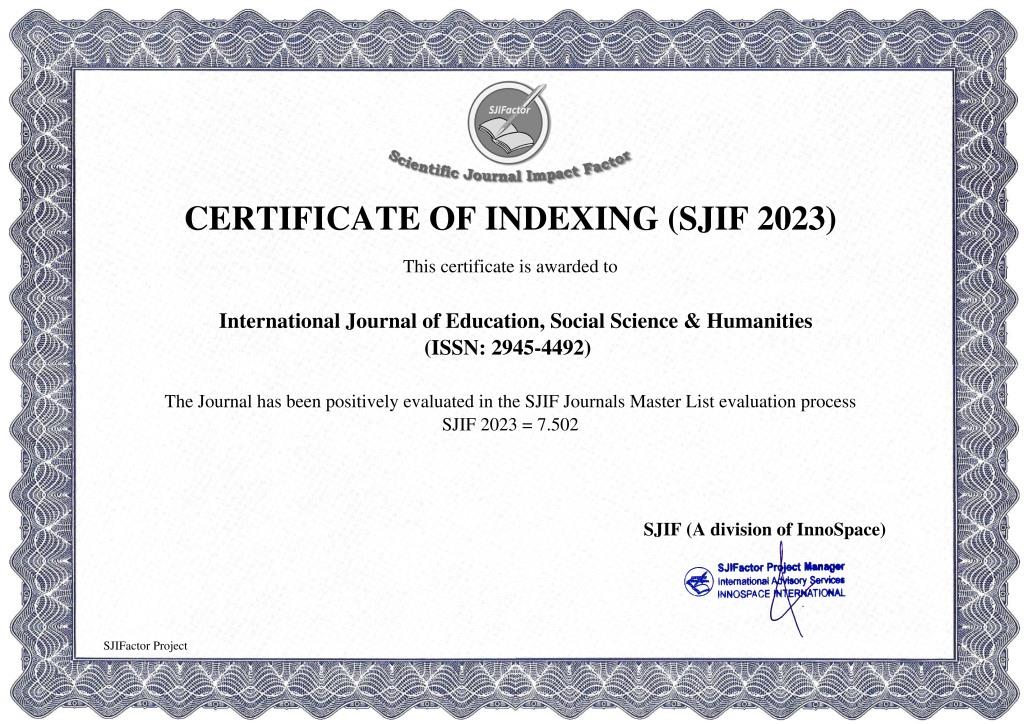THE IMPACT OF EMERGING TECHNOLOGIES (E.G., ARTIFICIAL INTELLIGENCE, BLOCKCHAIN) ON CYBERCRIME AND THE CHALLENGES THEY POSE FOR CYBER LAW ENFORCEMENT
Keywords:
emerging technologies, artificial intelligence, blockchain, cybercrime, cyber law enforcement, AI-driven cyber attacks, blockchain-based systems, legal and regulatory gaps, international cooperation, information sharing, public-private partnerships, policy and legislative reforms, capacity building, collaboration, future trends, implications, recommendations.Abstract
This study examines how new technologies, such as blockchain and artificial intelligence (AI), are affecting cybercrime and the difficulties they provide for cyber law enforcement. It analyzes real-world case studies, looks at how fraudsters use AI and blockchain for bad things, and pinpoints the dangers and weaknesses these technologies provide. The paper also examines the gaps in the rules and regulations surrounding the use of developing technologies and identifies the particular difficulties encountered by law enforcement organizations in preventing cybercrime. The ramifications for global collaboration and information exchange amongst law enforcement organizations are also covered. The essay ends with suggestions for policymakers, law enforcement organizations, and stakeholders to improve their capacity for cyber law enforcement and proposes topics for further study.
References
Varshney, A. (2020). Artificial intelligence in cybersecurity: A review. Journal of King Saud University-Computer and Information Sciences, 32(4), 436-449.
Pascual, J. C., Singh, M., & Kiran, R. U. (2019). Artificial intelligence and law enforcement. In Intelligent Systems for Security Informatics (pp. 113-139). Springer.
Xu, X., Weber, I., Staples, M., Zhu, L., Bosch, J., Bass, L., & Pautasso, C. (2017). A taxonomy of blockchain-based systems for architecture design. IEEE Software, 34(6), 20-27.
Santamaria, V., & Serrano, M. (2019). Blockchain technology for improving trustworthiness and visibility in supply chains. Industrial Electronics Magazine, 13(3), 28-35.
Hayes, A. S. (2017). Cryptocurrency value formation: An empirical analysis leading to a cost of production model for valuing bitcoin. Telematics and Informatics, 34(7), 1308-1321.
Smith, M., & Kumaraguru, P. (2019). Detecting socially engineered phishing personas using context-aware machine learning. Computers & Security, 85, 205-222. doi: 10.1016/j.cose.2019.05.005
Arp, D., Spreitzenbarth, M., Hubner, M., Gascon, H., Rieck, K., & Siemens, C. (2014). Practical attacks against authorship recognition techniques. Journal of Machine Learning Research, 15(1), 2771-2802.
Ahn, G., Hu, H., & Kormos, G. (2012). Investigating social engineering: The impact of conversational agents on human compliance. ACM Transactions on Information and System Security, 14(4), 1-27.
Cova, M., Felmetsger, V., Gonzalez, D., & Vigna, G. (2015). Detection and analysis of drive-by-download attacks and malicious JavaScript code. IEEE Transactions on Dependable and Secure Computing, 12(2), 138-150.
Casey, E. (2018). Artificial intelligence and the challenge of cybersecurity regulation. In J. Z. Berman (Ed.), The Cambridge Handbook of Artificial Intelligence (pp. 719-731). Cambridge University Press.
Zhang, Z., & Wang, J. (2021). The challenges and countermeasures of law enforcement against artificial intelligence-based cybercrime. In 2021 IEEE International Conference on Artificial Intelligence and Security (pp. 389-394). IEEE.
Ali, M., Fidalgo, R. N., Cheng, X., & Li, W. (2020). Techno-legal challenges in countering AI-driven cybercrime. In 2020 IEEE Congress on Evolutionary Computation (CEC) (pp. 1-8). IEEE.
Atzei, N., Bartoletti, M., & Cimoli, T. (2017). A survey of attacks on Ethereum smart contracts (SoK). In International Conference on Principles of Security and Trust (pp. 164-186). Springer.
Eyal, I. (2018). Majority is not enough: Bitcoin mining is vulnerable. Communications of the ACM, 61(7), 95-102.
Yarom, R., & Lindell, Y. (2019). Cryptocurrency laundering: An overview. IEEE Security & Privacy, 17(3), 81-85.
Nikolic, I., Kolluri, A., Sergey, I., Saxena, P., & Hobor, A. (2018). Finding the greedy, prodigal, and suicidal contracts at scale. In Proceedings of the 27th USENIX Security Symposium (pp. 1271-1288).
Kuo, T. T., & Li, Q. (2018). Exploring blockchain technology and its potential applications for cyber-physical systems. In Proceedings of the 14th International Conference on Wireless and Mobile Computing, Networking and Communications (WiMob) (pp. 1-6). IEEE.
Kim, Y., & Barnett, N. (2020). International cyber cooperation: A case study of collaboration against cybercrime. International Journal of Cyber Criminology, 14(1), 1-19.
Holt, T. J., & Bossler, A. M. (2015). Examining the applicability of lifestyle-routine activities theory for cybercrime victimization. Deviant Behavior, 36(3), 263-283.
Jaishankar, K. (Ed.). (2018). Cyber criminology: Exploring Internet crimes and criminal behavior (2nd ed.). CRC Press.
Kshetri, N. (2017). The economics behind cybercrime and cybersecurity. IEEE Security & Privacy, 15(3), 76-81.
Haggerty, K. D., & Ericson, R. V. (2018). The new politics of surveillance and visibility. University of Toronto Press.
Finklea, K. M. (2019). Cybercrime: An overview of the federal computer fraud and abuse statute and related federal criminal laws. Congressional Research Service.
Rogers, M. K. (2018). Policing cybercrime: Networked and social media technologies, criminalization, and law enforcement. International Journal of Comparative and Applied Criminal Justice, 42(3), 241-259.
Eckert, C., Bohm, C., & Hofmann, E. (2020). Deep learning for cybersecurity: A survey. Computers & Security, 93, 101844.
Arora, R., & Reimers, K. (2019). Legal aspects of artificial intelligence and blockchain. In Advances in Digital Technologies (pp. 135-146). Springer.
Chan, J. M. (2018). Public–private partnerships against cybercrime: The Singaporean experience. In The Palgrave Handbook of Criminology and the Global South (pp. 623-643). Palgrave Macmillan.
Buchholz, E. S., Joshi, K., & Raghavan, V. (2020). Public–private partnerships in cybersecurity: A systematic literature review. Computers & Security, 91, 101708.
Schneier, B. (2019). Click here to kill everybody: Security and survival in a hyper-connected world. WW Norton & Company.
Kamara, I., & Elmirghani, J. (2020). Legal and ethical challenges of blockchain technology. In Cybersecurity: The Insights You Need from Harvard Business Review (pp. 153-166). Harvard Business Review Press.
Jackson, C. M., & Golbeck, J. (2020). Adversarial machine learning and cybersecurity: A systematic literature review. IEEE Access, 8, 101540-101557.
Atzori, M., Iera, A., & Morabito, G. (2017). Blockchain-based architectures for the internet of things: A survey. IEEE Internet of Things Journal, 4(6), 1832-1843.
Ozer, M. C., & Onat, A. (2020). The role of public–private partnerships in cybersecurity: Case of Turkey. In Public-Private Partnerships for Infrastructure and Business Development (pp. 101-117). Springer.
Carter, D., & Raab, C. (2019). Developing police skills in combating cybercrime: A review of current practice in the UK. Policing: A Journal of Policy and Practice, 13(1), 81-95.
Kruger, J. (2021). International police cooperation in the digital age: Enhancing security in the 21st century. In Technoethics, Law, and Policy (pp. 159-180). Springer.
Hou, Y., & Zhang, Y. (2021). Explainable artificial intelligence: A survey. Artificial Intelligence Review, 54(5), 3725-3751.
Yli-Huumo, J., Ko, D., Choi, S., Park, S., & Smolander, K. (2016). Where is current research on blockchain technology?—A systematic review. PloS One, 11(10), e0163477.
McBride, J., Kim, D. S., & Ahn, G. J. (2019). The international legal framework for cyber security: Policy gaps and challenges. Telecommunications Policy, 43(3), 214-229.
Alazab, M., Hu, J., & Broadhurst, R. (2021). Cybercrime investigation and digital forensics education and training: A systematic review. Computers & Security, 107, 102311.
Kaati, L., Hedström, K., & Grönlund, Å. (2019). Multi-sectoral partnerships in cybersecurity: A systematic literature review. Government Information Quarterly, 36(2), 252-266.














